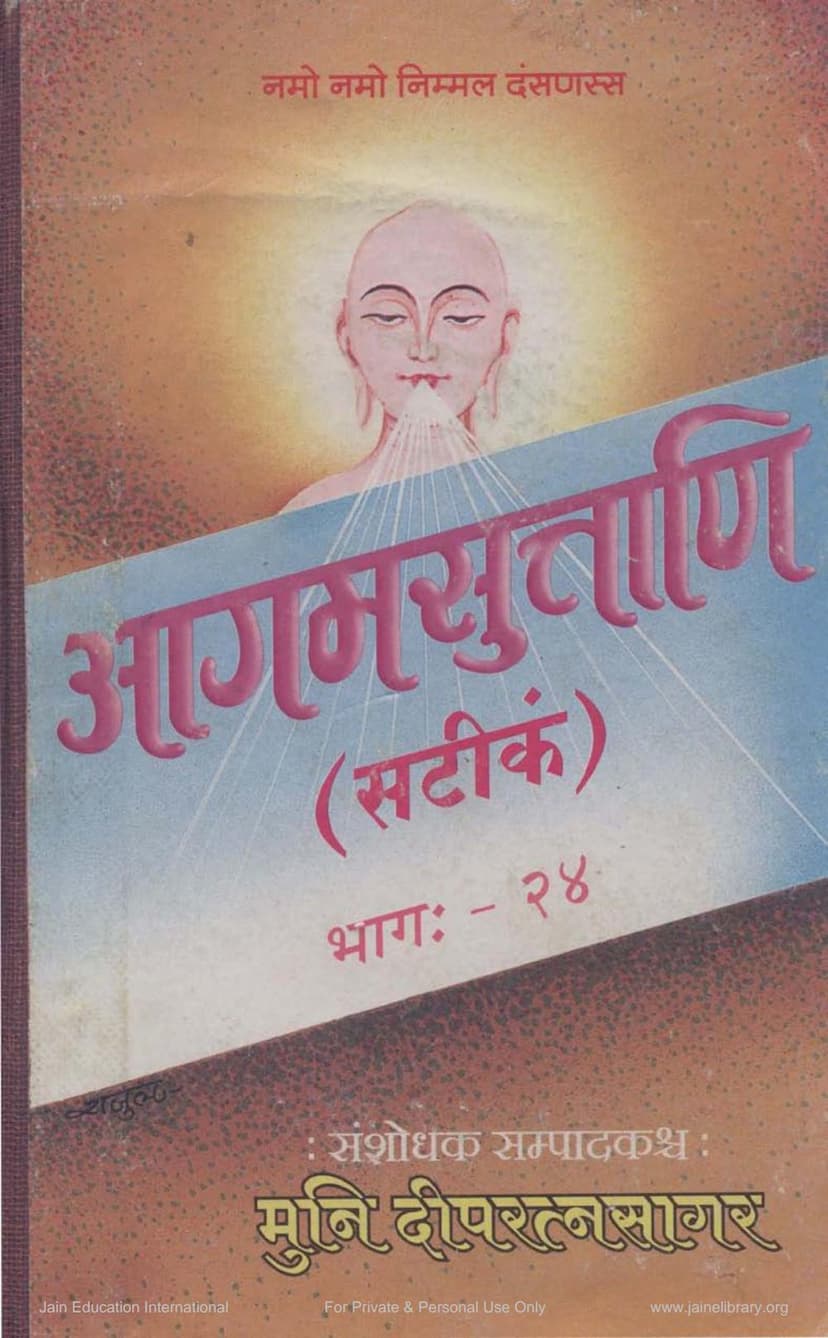Agam Sutra Satik 40 Aavashyak MoolSutra 1
Added to library: September 1, 2025

Summary
Here's a comprehensive summary of the Jain text "Agam Sutra Satik 40 Aavashyak MoolSutra 1," based on the provided text:
Book Title: Agam Sutra Satik 1 (Part 24) - 40 Aavashyak MoolSutra 1 Author: Muni Deepratnasagar (Compiler and Editor) Publisher: Agam Shrut Prakashan
Overview:
This text is the first part of the foundational Jain scripture, the Aavashyak Sutra, presented with a detailed commentary (Satik). It is a compilation and editorial work by Muni Deepratnasagar, published by Agam Shrut Prakashan. The text is part of a larger series of Agam Sutras.
Key Contents and Structure (Based on the Table of Contents - Page 3):
The book focuses on the Aavashyak Sutra, which is considered essential for Jain monks and nuns. The content is structured into various sections, including:
- Introduction/Preface (Pithika): This section likely introduces the importance of the Aavashyak Sutra, the purpose of the commentary, and the devotional greetings offered. It emphasizes the need for auspicious beginnings and understanding the purpose and meaning of the scripture.
- Main Text (Moolaanka): This forms the core of the book, presenting the original Aavashyak Sutra text.
- Commentary (Shatik/Vritti): The commentary delves into the meanings of the sutras, providing detailed explanations, grammatical analysis, philosophical insights, and sometimes historical or biographical narratives.
Specific Topics Covered (as indicated in the Table of Contents):
The table of contents provides a glimpse into the depth of the commentary on the Aavashyak Sutra, which typically covers:
- Namaskara (Salutation): Explaining the significance and meaning of the Panch Parmeshti Namaskara Mantra (Namo Siddhanam, Namo Arihantanam, etc.).
- Explanation of the Arhat Word: Delving into the etymology and significance of the term "Arhat."
- Nirikshepa (Classification/Categories): This is a crucial aspect of Jain philosophy, analyzing Siddhas, Acharyas, Upadhyayas, and Sadhus through various categories (Nirikshepa, Naya, Pramana, etc.). This involves understanding the essence, form, and function of these spiritual beings and concepts.
- Description of Siddhashila: Likely a description of the abode of liberated souls.
- Samayika: This is a central practice in Jainism, referring to the period of equanimity and meditation. The text explains its meaning, the rules and rituals associated with it (Samayika Sutra Swarupam, Karan Nirikshepa), and its purpose (Uddesh, Vachana, Anugya).
- Various Narratives and Teachings: The text also includes explanations related to:
- Mangal (Auspiciousness): The concept of auspicious beginnings and the role of mangal in scripture.
- Five Lights of Knowledge (Gyanasya Panchaprakasha): Likely referring to different types of knowledge.
- Upmakadi (Introduction, etc.): Indicating introductory and foundational elements.
- Upo-dhat (Preliminary Discourse): Preliminary explanations and contexts.
- Viradi Jinavaktavyata: Teachings related to various Jinas.
- Bharat Chakravarti Kathanakam: Narratives about Emperor Bharat.
- Baldev-Vasudev Kathanam: Stories of Baldev and Vasudev.
- Samavasarana Vyakhyata: Descriptions of the divine assemblies of the Jinas.
- Ganadhar Vaktavyata: Teachings attributed to the Ganadharas (chief disciples).
- Dashadha Samachari: Ten types of conduct or discipline.
- Nihava Vaktavyata: Discussions on refutations or denials.
- Upasamharah: Conclusion.
Commentary Style:
The commentary, attributed to Muni Deepratnasagar, appears to be highly detailed and scholarly. It engages in:
- Grammatical Analysis: Explaining the meaning of words and phrases, including etymology (e.g., Arhat word nirukti).
- Philosophical Interpretation: Discussing concepts like naya, pramana, nireksha, and the nature of reality.
- Narrative Elaboration: Recounting stories of Jain Tirthankaras, Chakravartis, and other significant figures to illustrate spiritual principles.
- Scriptural Cross-referencing: Likely referencing other Agam Sutras or commentaries for deeper understanding.
- Elaboration on Rituals and Practices: Explaining the specifics of Jain monastic conduct and devotional practices.
Publisher and Patronage:
Agam Shrut Prakashan is the publisher. The text also acknowledges financial supporters ("Aarthik Anurdata" on page 4), indicating a community effort in bringing this scripture to light, with various individuals and organizations contributing to its publication.
Spiritual Significance:
The Aavashyak Sutra is considered paramount for spiritual progress in Jainism, detailing the essential duties and practices of ascetics. The commentary aims to provide a comprehensive understanding of these vital teachings.
Overall:
"Agam Sutra Satik 40 Aavashyak MoolSutra 1" by Muni Deepratnasagar is a significant scholarly work that aims to preserve and explain a fundamental Jain scripture. The detailed commentary suggests a deep dive into the philosophical, ethical, and practical aspects of the Aavashyak Sutra, making it a valuable resource for serious students of Jainism.